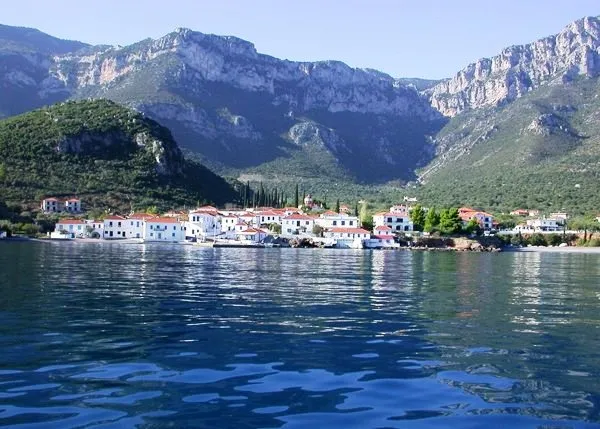Nestled at the foot of Mount Parnon, Kyparissi is one of the few remaining unspoiled traditional coastal settlements in the Peloponnese. With its picturesque charm and authentic character, it has preserved the essence of old-world Greece—something increasingly rare today.
Until the 1970s, Kyparissi remained completely cut off from the rest of the country, accessible only by sea or rugged trails. No roads led in or out. Perched about 100 meters above sea level and surrounded by dense Mediterranean vegetation—pines, carob trees, and of course, cypresses—it was designed to remain hidden. This deliberate isolation was not accidental. The village was built to escape the reach of pirates who once plundered the coastal settlements of the Peloponnese.
As pirate threats faded over time, coastal hamlets like Paralia and Mitropoli emerged below as Kyparissi’s seaside extensions. Today, this once-solitary village transforms into a tranquil summer getaway, attracting high-profile visitors seeking privacy and serenity—among them, Princess Diana and former U.S. President George Bush.
A Village Steeped in History
Kyparissi is built atop the ruins of the ancient city Kyfanta, renowned in antiquity for its natural springs. The area was also known as “Vrysi” (meaning “fountain”) due to its abundant waters. The name Kyfanta is believed to derive from the Greek word kyfos, meaning “curve” or “arch,” inspired by the dramatic mountain ridges and ravines surrounding the area.
Throughout the Classical and Hellenistic periods, Kyfanta alternated control between Sparta and Argos. By the Roman and early Byzantine eras, the city had vanished, leaving behind only traces of its former glory.
Around 1000 AD, a new settlement rose in the same area, eventually known as Kyparissi. The origin of the name is disputed—some say it comes from the abundant cypress trees (kyparissia in Greek), while others link it to a wealthy landowner named Kyparissis.
In ancient times, Kyfanta was home to a major Asklepieion, a healing sanctuary dedicated to Asclepius, the god of medicine. Patients would immerse themselves in carved stone basins filled with therapeutic spring water. According to mythology, the spring emerged when the huntress Atalanta struck a rock with her spear. A marble statue of Asclepius once stood in a sacred cave above the aqueduct—a location still accessible today via a steep footpath.
Legends and Folklore
The area is also rich in dramatic tales. One of the most notorious is the story behind "The Rock of the Horned One." In 1435, Franco Nero Acciaioli, the Duke of Athens, allegedly owned the region. During the Ottoman era, Kyparissi and its neighboring villages suffered under the devastating campaigns of Ibrahim Pasha, who ravaged the Peloponnese.
Villagers fled to Palaiochora to hide, only to be betrayed by a man named Skevis. Rumors say he either accepted a bribe or was coerced into revealing their location. Ibrahim's forces later hanged him from a prominent cliff—now called "The Rock of the Horned One," a name symbolizing betrayal and shame.
Preserving the Past
Today, Paralia—the seaside district of Kyparissi—is dotted with beautiful old houses that practically touch the sea. Their whitewashed walls and traditional architecture evoke the atmosphere of the Aegean islands. Many bear inscriptions with years like 1868, 1885, and 1895, a testament to their enduring history.
Visitors can still explore remnants of the ancient world:
The Asklepieion in Vrysi
The Byzantine Castle in the Kastro area
The ancient city of Kyfanta, known today as Palaiochora
Religious landmarks include the Church of the Dormition of the Virgin Mary (built in 1893) and Holy Trinity Church (built in 1883). Another site of interest is the village school, constructed in the early 1900s. During the German occupation, it was commandeered by Axis forces.
Nearby Secrets: Kapsala and the Exiled Killers
Close to Kyparissi lies the forgotten village of Kapsala, once a refuge for the assassins of Ioannis Kapodistrias, Greece’s first head of state. The Mavromichalis family, central figures in his assassination, sought shelter there to escape public outrage. Many current residents still bear the surname Mavromichalis.
Folklore claims the village got its name from the word "kapsalismenoi"—those burned by the shame and anger of their actions.
A Hidden Paradise by the Sea
Beyond its historical richness, Kyparissi boasts stunning beaches. Between Paralia and Mitropoli lies Megali Ammos, a wide beach with white pebbles and crystal-clear waters. To the north is Agia Kyriaki, a quieter pebbled beach whose southern end is often deserted—reached only by foot.
For those with access to a boat, a number of secluded coves are waiting to be discovered:
Drymiskos Bay
Vlychada Beach, hidden and serene
Balogkeri, a truly off-the-beaten-path gem
Kyparissi is not just a beautiful coastal retreat—it’s a living museum of history, mythology, and tradition. Tucked away from the rush of modern life, it remains a rare treasure where nature, legend, and legacy coexist in peaceful harmony.










